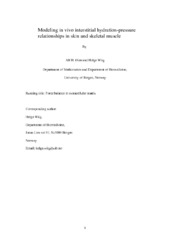Modeling In Vivo Interstitial Hydration-Pressure Relationships in Skin and Skeletal Muscle
Peer reviewed, Journal article
Accepted version
Permanent lenke
https://hdl.handle.net/1956/19348Utgivelsesdato
2018-09Metadata
Vis full innførselSamlinger
Sammendrag
A theoretical understanding of hydrostatic pressure-fluid volume relationships, or equations of state, of interstitial fluid in skin and skeletal muscle through mathematical/physical modeling is lacking. Here, we investigate at the microscopic level forces that seem to underlie and determine the movements of fluid and solid tissue elements on the microscopic as well as on the macroscopic level. Effects that occur during variation of hydration due to interaction between expanding glycosaminoglycans (GAGs) and the collagen interstitial matrix of tissue seem to be of major importance. We focus on these interactions that let effects from spherical GAGs expand and contract relative to collagen on the microscopic level as hydration changes and thereby generate a hydration-dependent electrostatic pressure on the extracellular matrix on the microscopic level. This pressure spreads to macroscopic levels and become a key factor for setting up equations of state for skin and skeletal muscle interstitia. The modeling for a combined skeletal muscle and skin tissue is one dimensional, i.e., a flat box that may mimic central transverse parts of tissue with more complex geometry. Incorporating values of GAG and collagen densities and fluid contents of skin and muscle tissues that are of an order of magnitude found in literature into the model gives interstitial hydrostatic pressure- fluid volume relationships for these tissues that agree well with experimental results.
